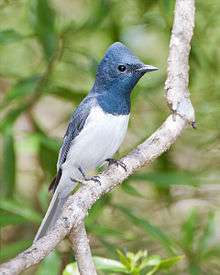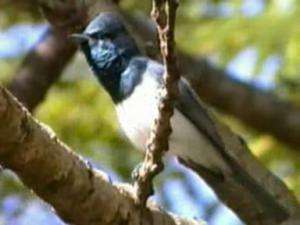Leaden flycatcher
| Leaden flycatcher | |
|---|---|
 | |
| Male, showing white breast | |
 | |
| Female, with prey | |
| Scientific classification | |
| Kingdom: | Animalia |
| Phylum: | Chordata |
| Class: | Aves |
| Order: | Passeriformes |
| Family: | Monarchidae |
| Genus: | Myiagra |
| Species: | M. rubecula |
| Binomial name | |
| Myiagra rubecula (Latham, 1801) | |
| Subspecies | |
|
See text | |
The leaden flycatcher (Myiagra rubecula) is a species of passerine bird in the family Monarchidae. Around 15 cm (6 in) in length, the male is a shiny lead-grey with white underparts, while the female has grey upperparts and a rufous throat and breast. It is found in eastern and northern Australia, Indonesia, and Papua New Guinea. Its natural habitat is subtropical or tropical mangrove forests in the northern parts of its range, in the south and inland it is eucalypt woodland.
Taxonomy
The leaden flycatcher was first described by the English ornithologist John Latham in 1801, from an illustration of a female bird in the Watling drawings. He coined the English name "Red-breasted tody" and the binomial name Todus rubecula.[2][3] Its specific name, rubecula, comes from the Latin for robin.[4] A local name around Sydney is frogbird, derived from its guttural call.[5] Other variants of its common name include blue- or leaden-coloured flycatcher.[6] John Gould described and named the Pretty Flycatcher (Myïagra concinna) in 1848, which has since been subsumed into this species.[7]
The leaden flycatcher is a member of a group of birds termed monarch flycatchers. This group is considered either as a subfamily Monarchinae, together with the fantails as part of the drongo family Dicruridae,[8] or as a family Monarchidae in its own right.[9] They are not closely related to either their namesakes, the Old World flycatchers of the family Muscicapidae; early molecular research in the late 1980s and early 1990s revealed the monarchs belong to a large group of mainly Australasian birds known as the Corvida parvorder comprising many tropical and Australian passerines.[10] More recently, the grouping has been refined somewhat as the monarchs have been classified in a 'Core corvine' group with the crows and ravens, shrikes, birds of paradise, fantails, drongos and mudnest builders.[11]
Subspecies
There are six subspecies recognized:[12]
- M. r. sciurorum - Rothschild & Hartert, 1918: found on the D'Entrecasteaux Islands and the Louisiade Archipelago
- M. r. papuana - Rothschild & Hartert, 1918: found on southern and south-eastern New Guinea, islands of the Torres Strait
- Pretty Flycatcher (M. r. concinna) - Gould, 1848: found in north-western and north-central Australia.
- M. r. okyri - Schodde & Mason, IJ, 1999: an unusual non-migratory form found on Cape York Peninsula (north-eastern Australia). The specific epithet is an anagram of yorki. The holotype was collected from Coen in northern Queensland.[13]
- M. r. yorki - Mathews, 1912: found in north-eastern and eastern Australia
- M. r. rubecula - (Latham, 1801): found in south-eastern Australia.
Description
.jpg)
Kobble Creek, SE Queensland
The leaden flycatcher is 14.5–16 cm (6-6½ in) long and weighs around 10–15 g. It is a shiny lead-grey in colour with a brownish tinge to the wings, a bluish black bill, black legs and dark brown iris. The male has darker grey lores, and a white breast and belly, while the female has an orange-tan throat and breast with a white belly. The juvenile resembles the adult female, but with paler wing-edges.[6]
Distribution and habitat
The leaden flycatcher is found from King Sound in northwestern Australia, across the Top End to Cape York, and then down the east coast to central-southern Victoria. It is rare in Tasmania. It is highly migratory within this range. Sclerophyll forest, rainforest margins, mangroves and coastal scrub are the preferred habitats.[14]
Behaviour
As its name suggests, the leaden flycatcher is insectivorous. A very active and agile bird, it hops between branches and catches insects in flight.[6]
Breeding
Breeding season is September to February with one brood raised. The nest is a deep cup made of strips of bark and dry grass, woven together with spider webs and decorated with lichen, generally sited on a small branch well away from the trunk of a sizeable tree some 5–10 m above the ground. Two or three white eggs tinted bluish, greyish or lavender and splotched with dark grey-brown are laid measuring 17 mm x 14 mm. They have an unusual swollen oval shape.[14] The species is parasitised by the brush cuckoo (Cacomantis variolosus).[14] Both sexes incubate the eggs and brood the chicks, although the female undertakes slightly more of the duties and also incubates at night.[15] Nesting success is low, with only 23% of nests successfully fledging a chick.

References
- ↑ BirdLife International (2012). "Myiagra rubecula". IUCN Red List of Threatened Species. Version 2013.2. International Union for Conservation of Nature. Retrieved 26 November 2013.
- ↑ Latham, John (1801). Supplementum indicis ornithologici sive systematis ornithologiae (in Latin). London: Leigh & Sotheby. p. xxxii.
- ↑ Boles (The Robins and Flycatchers of Australia), p. 322
- ↑ Jobling, James A (1991). A Dictionary of Scientific Bird Names. OUP. ISBN 0 19 854634 3.
- ↑ Boles (The Robins and Flycatchers of Australia), p. 320
- 1 2 3 Boles (The Robins and Flycatchers of Australia), p. 325
- ↑ Gould, J (1848). "Descriptions of some new species of Australian birds". Proc. Zool. Soc. Lond. 1847 (15): 220–222 [221].
- ↑ Christidis L, Boles WE (1994). The Taxonomy and Species of Birds of Australia and its Territories. Melbourne: RAOU.
- ↑ Christidis L, Boles WE (2008). Systematics and Taxonomy of Australian Birds. Canberra: CSIRO Publishing. p. 174. ISBN 978-0-643-06511-6.
- ↑ Sibley, Charles Gald & Ahlquist, Jon Edward (1990): Phylogeny and classification of birds. Yale University Press, New Haven, Conn.
- ↑ Cracraft J, Barker FK, Braun M, Harshman J, Dyke GJ, Feinstein J, Stanley S, Cibois A, Schikler P, Beresford P, García-Moreno J, Sorenson MD, Yuri T, Mindell DP (2004). "Phylogenetic relationships among modern birds (Neornithes): toward an avian tree of life". In Cracraft J, Donoghue MJ. Assembling the tree of life. New York: Oxford Univ. Press. pp. 468–89. ISBN 0-19-517234-5.
- ↑ "IOC World Bird List 6.4". IOC World Bird List Datasets. doi:10.14344/ioc.ml.6.4.
- ↑ Schodde R, Mason IJ (1999). The Directory of Australian Birds : Passerines. A Taxonomic and Zoogeographic Atlas of the Biodiversity of Birds in Australia and its Territories. Collingwood, Australia: CSIRO Publishing. p. 510.
- 1 2 3 Beruldsen, G (2003). Australian Birds: Their Nests and Eggs. Kenmore Hills, Qld: self. pp. 367–68. ISBN 0-646-42798-9.
- ↑ Trémont S. & H. Ford (2000) "Partitioning of Parental Care in the Leaden Flycatcher". Emu 100 (1): 1 – 11 doi:10.1071/MU9834
Cited text
- Boles, Walter E. (1988). The Robins and Flycatchers of Australia. Sydney: Angus & Robertson. ISBN 0-207-15400-7.
External links
| Wikimedia Commons has media related to Myiagra rubecula. |
| Wikispecies has information related to: Myiagra rubecula |
- "First Fleet artwork collection: The Watling collection: Red-breasted Tody". London: Natural History Museum.
